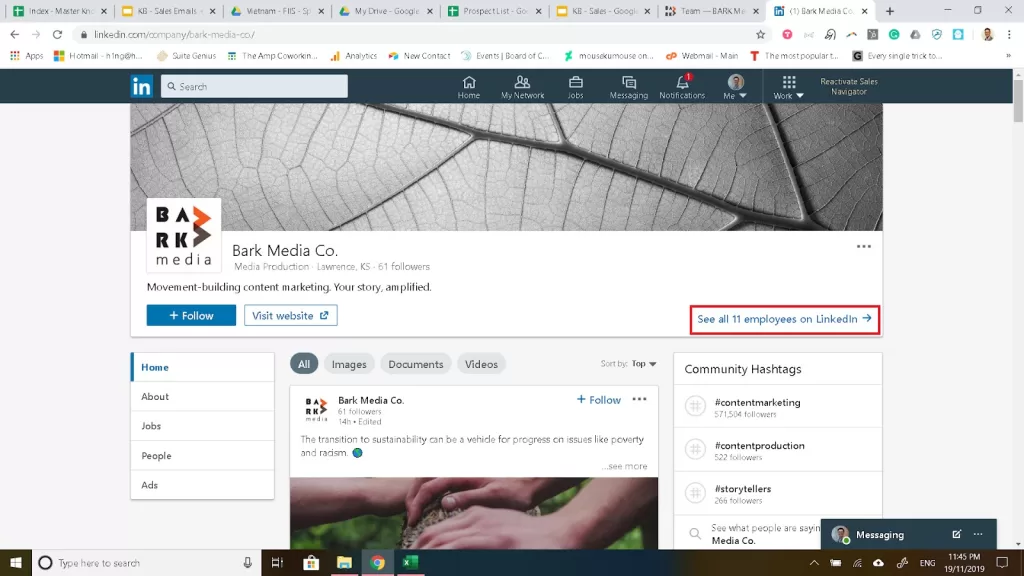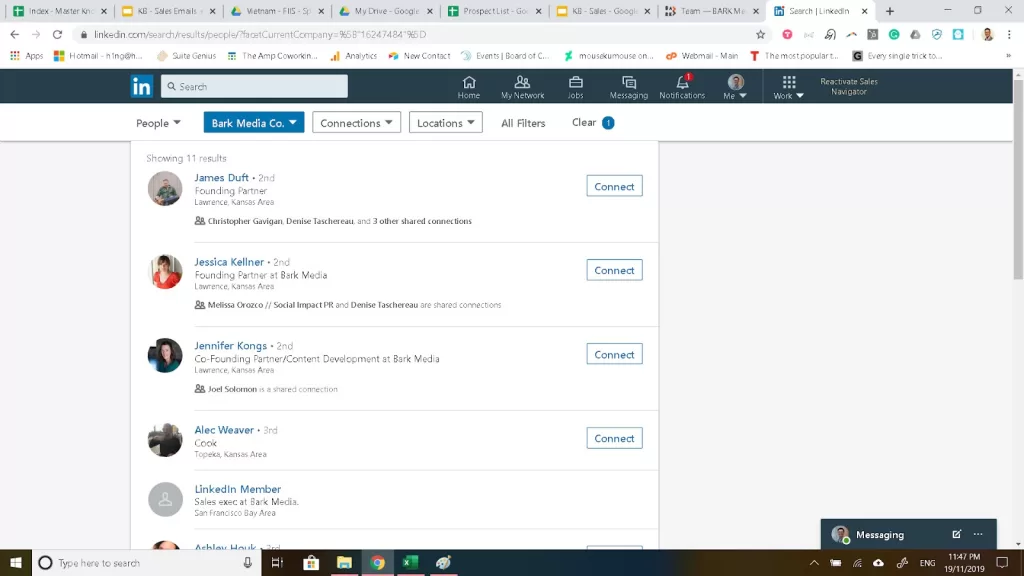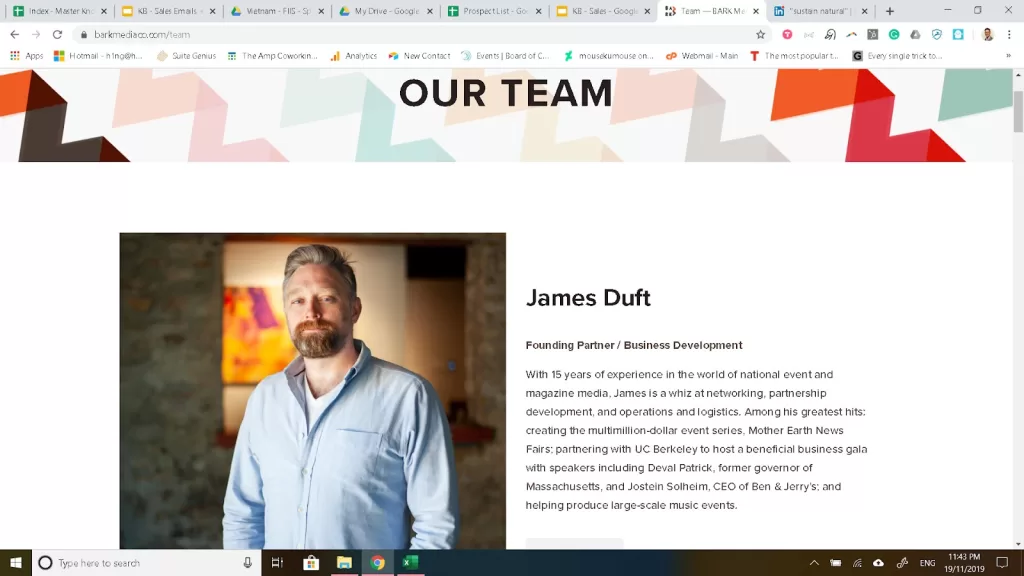Here’s an overview of the process, which we’ll go into more detail:
Step 1: Create a list of companies
Step 2: Identify potential decision-maker(s)
Step 3: Guess their email
Step 4: Clean your list
Step 5: Craft and review your copy for spamminess
Step 6: Mail merge
Step 7: Automate the above
Step 1: Create a List of Companies
Your first step is to start a spreadsheet you can begin to populate. Begin by identifying potential sources for leads. Ask yourself the following questions:
- Where do my prospects hang out?
- Are they active in certain groups or forums?
- Do they attend industry or topic-specific conferences or trade shows?
- Do they commonly have memberships in certain associations?
- Are there specific certifications or awards they covert?
- Are they listed in particular government directories?
- How do they currently seek solutions or address their problems?
- What keywords do they use when searching?
- What are some notable blogs on the topic?
- Is a workshop or webinar a preferred method of learning?
- Do they subscribe to specific newsletters?
- Who are some specific channels or content creators they might follow?
- Are there popular videos they would have likely watched or engaged with?
- What are my competitors doing? If it works for them, it will probably work for you too.
- Who are potential referral partners? Who are non-competitors that also serve your prospects in different ways that you don’t?
- You can also leverage case studies or testimonials, not only for credibility but also to drive referrals. This can be done by asking the company that was willing to provide it to share it with their network. They are often happy to do so as it features them as well. Similar companies will likely exist in their network.
- Are they self-identifying with specific keywords on platforms like LinkedIn?
- In their job title, bios, experiences, or skills.
- For instance, if you sell sales software, you may target a sales operations person who has recently changed jobs (as they may be more motivated to implement new changes).
As you build your list, differ judgment. Qualify as much as possible, but don’t discard a prospect by assuming they won’t buy. Your goal at this point is to compile a list of potential customers. As you work through the process, you’ll qualify them in more detail. The process should also continue to evolve and improve; don’t rush to populate your list yet. Aim for about 50 entries to start and test your lead source for effectiveness before proceeding. You may decide to discontinue a lead source if you find too many of the leads tend to be unqualified or uninterested,
Example Tools: Canada’s Business Registries, Owler, LinkedIn Search
If you know a specific list, you can even try searching “list name.csv” to see if an unprotected spreadsheet exists on the web. For instance, when looking for social ventures, I decided it might be a good idea to build a list of companies that were B Corp certified. By searching “BCorp.csv”, I was able to pull a list with over 14,000 entries from Data.world.
Here’s a spreadsheet template to get you started with your list building:

Step 2: Identify Potential Decision-makers(s)
Now that you have some potential companies in your spreadsheet, the next step is to identify potential decision-makers. The plural form is used because it’s often difficult, especially with larger organizations, to identify the right decision-maker. Remember, as long as you do it correctly and don’t spam everyone with the same message, it’s also acceptable to reach out to multiple people in the same organization.
There are two main ways to do this:
1. LinkedIn: Search for people who work at the organization by viewing their employees on their company page


2. Navigate to their “About Us” or “Team” page on their website: This is often available with smaller or medium-sized organizations but rarely possible with larger ones.

Step 3: Guess Their Email
Knowing their physical address might be the most effective if you’re targeting a retail or restaurant establishment. But assuming you aren’t, a person’s phone number might be your best option. People are much less likely to change their phone numbers, and you can directly control the delivery of your messaging through it compared to a social media platform, where visibility is entirely dependent on what the most current algorithm favors. However, cold calling isn’t always the best option. Not because I’m a millennial or an introvert, but because my generation and younger actually prefer text-based communication. Calling is sometimes a little too personal, and many others will have a similar policy as I do: to ignore all calls from unrecognized numbers. I have, however, found cold calling to be the best option in certain scenarios, like if you’re going after baby boomers or targeting businesses in remote locations where internet access isn’t their first choice.
The next best option is email. This is because, like a phone number, it is relatively static and unchanging once assigned, and because the ROI on it is high considering the time invested in crafting an email and the ability to send multiple similar yet highly personalized emails at once via mail merge.
Example Tools: Hunter.io, VoilaNorbert
If nothing comes back, which can be the case for a newer company or one with strict email masking and public disclosure policies, here are some common formats you can try:
- Jordan@Company.com
- Chang@Company.com
- Jordan.Chang@Company.com (replace . with -, _, or remove it for alternative formats)
- Chang.Jordan@Company.com
- J.Chang@Company.com
- Jordan.C@Company.com
- Chang.J@Company.com
- C.Jordan@Company.com
If it’s a high-priority prospect, you may even be willing to invest more time and resources to take a more direct and personal approach to connect with them and build a relationship, besides email:
1. Find a warm introduction
Do you have a direct contact who might know them and be willing to facilitate an introduction or refer you? If you don’t already have a direct contact, it may also be easier to establish a relationship with someone else who is close to them (friends, colleagues, mentees, family, or peers in their industry). Do this sincerely, not solely for the sake of obtaining a referral.
A true story, not from a sales situation, but it applies. I have a friend who wanted to make a particular business leader his mentor. He got to know all the mentees of this leader and even his wife! When he was finally introduced, what the leader said affirmed his approach “I’ve heard so much about you, even my wife has mentioned you…”. He did go on to work under this leader as a mentee for a few years.
2. Where do they hang out and how do they engage, both in-person and online?
Are they vocal about specific topics or causes? Do they post in certain forums, are vocal about specific discussions, or engage with certain hashtags? Are there specific events they attend? These could be either professional or personal. Try to find ways to get on their radar and be noticed where they’re active.
For instance, we worked with an entrepreneur who was raising capital at Spring Activator. He was targeting a specific investor whom he really wanted for his investment round. He discovered that this investor was politically vocal on Twitter and deliberately engaged with him in a discussion thread. The entrepreneur didn’t simply agree with everything or flatter the investor. In fact, he was well-informed and had a different opinion on some of the points the investor raised. He engaged in intelligent debate. This eventually led to him meeting the investor for a discussion over beer, and long story short, the investor invested in his company.
Step 4: Clean Your List
By now, you should have the following columns in your spreadsheet:
- Company Name
- Website
- First Name
- Last Name
- Email Address
- Job Title/Role
Exclude extra columns like these, even if they seem important unless you’re deliberately testing their effectiveness:
- Company Size
- Industry
- Age of business
Here’s a basic cleaning routine to follow:
- Dedupe: Duplicate entries often occur during data entry.
- Check First Names: Use personalized short handles if appropriate.
- E.g. Christopher → Chris
- Tidy Company Name: Remove prefixes like “The…” and suffixes like LTD, LLP, Group, or Company.
- Remove all leading and trailing spaces in any entry.
Example Tool: PowerTools by AbleBits (Google Sheet plugin)
You should also put all the emails through an email verification tool because:
- There may have been a typo in their email.
- They may have already left the organization.
- Or perhaps the email format you guessed was incorrect.
Example Tools: Bulk Email Checker, Email Checker, EmailHippo
Step 5: Craft and Review Your Copy for Spamminess
Now’s the time to draft your email outreach messages. I’ll discuss a detailed outreach messaging workflow in the next section, but some high-level advice here is to avoid including too many links or salesy keywords like “free” or “buy”.
Example Tools: Mail Tester, M@ilGenius
Step 6: Mail Merge
Most tools should enable you to track email open rates, clickthrough rates (if links were included), and response rates. Additionally, you can add extra columns to your spreadsheet, such as status, objections, decline reasons, send date, reply date, and more. This allows for quick comparison and filtering when analyzing the effectiveness of your campaign.
Step 7: Automate The Above
Do a few of the above yourself so you have a rough expectation of:
How many entries you can capture in an hour
So you know what to expect when you decide to outsource this work and have a benchmark to compare average performance vs. poor or excellent.
Quality of the list source
As mentioned before, tech is a loudspeaker; automating prematurely can result in a lot of unnecessary noise. It might be the case that there are other more suitable companies to reach out to or other directories with better quality or more updated information.
The right process
For instance, if there are multiple potential decision-makers, manual testing will give you the chance to better determine who is the right person to initiate the conversation with. Doing so will also allow you to test different email subject lines, copy, and CTAs to ensure you get the messaging right before you send en masse.
Once you’re ready, you can “automate” this repetitive work by outsourcing it. I anticipate AI will eventually develop the capability to perform this type of simple research and data entry. However, currently, some degree of human judgment is still necessary for identifying the potential decision-maker(s).
Popular freelancing platforms: Upwork, Fiverr, Freelancer
When it comes to outsourcing list building, here are some helpful pointers:
Avoid buying lists
Some companies may offer to sell you lists of prospects. I generally don’t recommend this approach, as these lists are often recycled and sold to multiple buyers. The contacts on these lists often receive a high volume of cold emails, meaning your email will likely get lost in the noise or, worse, end up in their spam or promotions folder.
When hiring freelancers, ensure you provide clear and specific instructions
Without them, some may not be the best decision-makers or problem solvers, leading to slower execution or even getting stuck on the project. For instance, you might specify:
- Identify decision makers in this priority order: Owner, VP of Sales, Sales Manager.
- Only enter a maximum of 2 contacts for a company (i.e., if you already have the Owner & VP of Sales, you do not need to find a contact for the Sales Manager).
- If no obvious potential decision-makers can be found, skip to the next entry; do not spend more than 5 minutes per company.
- If their email format isn’t discoverable through hunter.io, verify with these 3 formats and skip to the next entry if none of them are valid:
- Jordan@Company.com
- Chang@Company.com
- Jordan.Chang@Company.com
Test multiple freelancers with the same list
This allows you to identify the best one to continue working with. Don’t only look for the one that provides the most entries per hour; ensure they also maintain a low rate of duplicates and errors. Assign different segments of the list to each freelancer to minimize overlap and ensure data from each freelancer you’re testing remains useful to you.
Automate gradually and in batches
Before going full throttle, restrict the number of hours your freelancer may work each week so you can test the list and refine your copy. If you’re seeing positive results, feel free to proceed at full speed. However, if the outcomes aren’t satisfactory, consider pausing or stopping your experiment to try a different list, subject lines, email copy, or CTA.
TEMPLATE
Here’s a spreadsheet template to get you started with your list building:

